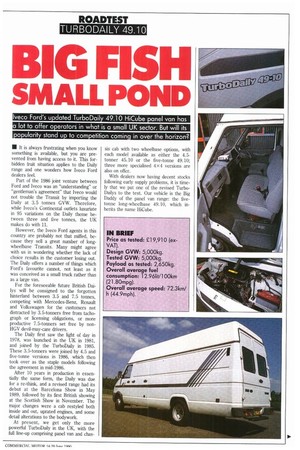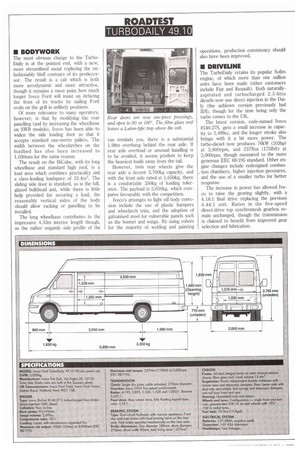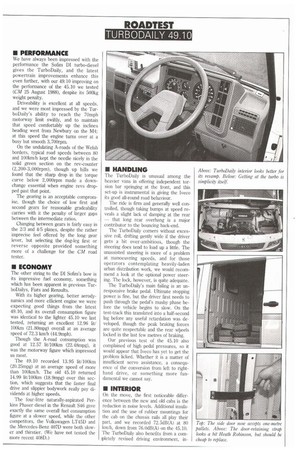BIG FISH
Page 45

Page 46

Page 47

Page 48

If you've noticed an error in this article please click here to report it so we can fix it.
SMALL POND
Iveco Ford's u dated Turbo Dail 49.10 HiCube •anel van has
a lot to offer o•erators in what is a small UK sector. But will its
• o•ularit stand u• to com•etition comm. in over the horizon?
• It is always frustrating when you know something is available, but you are prevented from having access to it. This forbidden fruit situation applies to the Daily range and one wonders how Iveco Ford dealers feel.
Part of the 1986 joint venture between Ford and Iveco was an "understanding" or "gentleman's agreement" that Iveco would not trouble the Transit by importing the Daily at 3.5 tonnes GVW. Therefore, while Iveco's Continental outlets luxuriate in 95 variations on the Daily theme between three and five tonnes, the UK makes do with 11.
However, the Iveco Ford agents in this country are probably not that miffed, because they sell a great number of longwheelbase Transits. Many might agree with us in wondering whether the lack of choice results in the customer losing out. The Daily offers a number of things which Ford's favourite cannot, not least as it was conceived as a small truck rather than as a large van.
For the foreseeable future British Dailys will be consigned to the forgotten hinterland between 3.5 and 7.5 tonnes, competing with Mercedes-Benz, Renault and Volkswagen for the customers not distracted by 3.5-tonners free from tachograph or licensing obligations, or more productive 7.5-tonners set free by nonHGV devil-may-care drivers.
The Daily first saw the light of day in 1978, was launched in the UK in 1981, and joined by the TurboDaily in 1985. These 3.5-tonners were joined by 4.5 and five-tonne versions in 1986, which then took over as the staple models following the agreement in mid-1986.
After 10 years in production in essentially the same form, the Daily was due for a re-think, and a revised range had its debut at the Barcelona Show in May 1989, followed by its first British showing at the Scottish Show in November. The major changes were a cab restyled both inside and out, uprated engines, and some detail alterations to the bodywork.
At present, we get only the more powerful TurboDaily in the UK, with the full line-up comprising panel van and chas
sis cab with two wheelbase options, with each model available as either the 4.5tonner 45.10 or the five-tonne 49.10; three more specialised 4 X4 versions are also on offer.
With dealers now having decent stocks following early supply problems, it is timely that we put one of the revised TurboDailys to the test. Our vehicle is the Big Daddy of the panel van range: the fivetonne long-wheelbase 49.10, which inherits the name HiCube.
• BODYWORK
The most obvious change to the TurboDaily is at the pointed end, with a new, more streamlined snout replacing the unfashionably bluff contours of its predecessor. The result is a cab which is both more aerodynamic and more attractive, though it remains a moot point how much longer Iveco Ford will insist on defacing the front of its trucks by nailing Ford ovals on the grill in unlikely positions.
Of more relevance to many operators, however, is that by modifying the rear panelling (and by increasing the wheelbase on SWB models), Iveco has been able to widen the side loading door so that it accepts standard one-metre pallets. The width between the wheelarches on the loadbed has also been increased to 1,030mm for the same reason.
The result on the HiCube, with its long wheelbase and standard high roof, is a load area which combines practicality and a class-leading loadspace of 15.4m3. The sliding side door is standard, as is the full, glazed bulkhead and, while there is little help provided for securing a load, the reasonably vertical sides of the body should allow racking or panelling to be installed.
The long wheelbase contributes to the impressive 4.53m interior length though, as the rather ungainly side profile of the van reminds you, there is a substantial 1.98m overhang behind the rear axle. If rear axle overload or unusual handling is to be avoided, it seems prudent to keep the heaviest loads away from the tail.
However, twin rear wheels give the rear axle a decent 3,700kg capacity, and with the front axle rated at 1,650kg, there is a comfortable 350kg of loading tolerance. The payload is 2,650kg, which compares favourably with the competition.
Iveco's attempts to fight off body corrosion include the use of plastic bumpers and wheelarch trim, and the adoption of galvanised steel for vulnerable panels such as the bonnet and wings. By using robots for the majority of welding and painting operations, production consistency should also have been improved.
• DRIVELINE
The TurboDaily retains its popular Sofim engine, of which more than one million units have been made (other customers include Fiat and Renault). Both naturallyaspirated and turbocharged 2.5-litre diesels now use direct injection in the Daily (the unblown version previously had IDI), though for the time being only the turbo comes to the UK.
The latest version, code-named Iveco 8140.27S, gets a small increase in capacity to 2,499cc, and the longer stroke also brings with it a bit more power. The turbo-diesel now produces 76kW (103hp) at 3,800rpm, and 237Nm (175Ibft) at 2,000rpm, though measured to the more generous EEC 88/195 standard. Other engine changes include redesigned combustion chambers, higher injection pressures, and the use of a smaller turbo for better response.
The increase in power has allowed Iveco to raise the gearing slightly, with a 4.18:1 final drive replacing the previous 4.44:1 unit. Ratios in the five-speed direct-drive top synchromesh gearbox remain unchanged, though the transmission is claimed to benefit from improved gear selection and lubrication.
• PERFORMANCE
We have always been impressed with the performance the Sofim DI turbo-diesel gives the TurboDaily, and the latest powertrain improvements enhance this even further, with our 49.10 improving on the performance of the 45.10 we tested (CM 25 August 1988), despite its 500kg weight penalty.
Driveability is excellent at all speeds, and we were most impressed by the TurboDaily's ability to reach the 70mph motorway limit swiftly, and to maintain that speed comfortably up the inclines heading west from Newbury on the M4; at this speed the engine turns over at a busy but smooth 3,700rpm.
On the undulating A-roads of the Welsh borders, typical road speeds between 80 and 100km/h kept the needle nicely in the solid green section on the rev-counter (2,200-3,000rpm), though up hills we found that the sharp drop in the torque curve below 2,000rpm made a downchange essential when engine revs dropped past that point.
The gearing is an acceptable compromise, though the choice of low first and second gears for reasonable gradeability carries with it the penalty of larger gaps between the intermediate ratios.
Changing between gears is fairly easy in the 2/3 and 4/5 planes, despite the rather imprecise feel offered by the long gear lever, but selecting the dog-leg first or reverse opposite provided something more of a challenge for the CM road tester.
• ECONOMY
The other string to the DI Softm's bow is its impressive fuel economy, something which has been apparent in previous TurboDailys, Fiats and Renaults.
With its higher gearing, better aerodynamics and more efficient engine we were expecting good things from the latest 49.10, and its overall consumption figure was identical to the lighter 45.10 we last tested, returning an excellent 12.96 lit/ 100km (21.80mpg) overall at an average speed of 72.3 km/h (44.9mph).
Though the A-road consumption was good at 12.57 lit/100km (22.48mpg), it was the motorway figure which impressed us most.
The 49.10 recorded 13.95 lit/100km (20.25mpg) at an average speed of more than 100kna/h. The old 45.10 returned 14.99 lit/100km (18.9mpg) over this section, which suggests that the faster final drive and slippier bodywork really pay dividends at higher speeds.
The four-litre naturally-aspirated Perkins Phaser diesel in the Renault S46 gave exactly the same overall fuel consumption figure at a slower speed, while the other competitors, the Volkswagen LT45D and the Mercedes-Benz 407D were both slower and thirstier. (We have not tested the more recent 408D.)
• HANDLING
The TurboDaily is unusual among the heavier vans in offering independent torsion bar springing at the front, and this set-up is instrumental in giving the Iveco its good all-round road behaviour.
The ride is firm and generally well controlled, though taking bumps at speed reveals a slight lack of damping at the rear — that long rear overhang is a major contributor to the bouncing back-end.
The TurboDaily corners without excessive roll, drifting gently wide if the driver gets a bit over-ambitious, though the steering does tend to load up a little. The unassisted steering is more of a problem at manoeuvring speeds, and for those operators contemplating heavily-laden urban distribution work, we would recommend a look at the optional power steering. The lock, however, is quite adequate.
The TurboDaily's main failing is an unresponsive brake pedal. Ultimate stopping power is fine, but the driver first needs to push through the pedal's mushy phase before the vehicle begins to slow. On the test-track this translated into a half-second lag before any useful retardation was developed, though the peak braking forces are quite respectable and the rear wtleels locked in the last few metres of braking.
Our previous test of the 45.10 also complained of high pedal pressures, so it would appear that lveco has yet to get the problem licked. Whether it is a matter of insufficient servo assistance, a consequence of the conversion from left to righthand drive, or something more fundamental we cannot say.
• INTERIOR
On the move, the first noticeable difference between the new and old cabs is the reduction in noise levels. Additional insulation and the use of rubber mountings for the cab on the chassis rails all play their part, and we recorded 72.5dB(A) at 80 km/h, down from 76.0dB(A) on the 45.10. The TurboDaily also benefits from a cornlpletely revised driving environment, in eluding a redesigned fascia, cloth seats and an uprated heating and ventilation system.
The result is an attractive and efficient cab, which manages rather better than most to bridge the gap between van and truck interiors; it certainly leaves the Mercedes cab looking particularly austere and old-fashioned. Instrumentation is clearly marked, controls are well sited, and there is plenty of oddments space.
A height-adjustable seat helps tailor the driving position to suit most shapes and sizes and, although the sloping nose dips out of view from the cab, visibility to front and rear is good. The pedal positions, as in other semi-forward-control designs, are compromised by being squeezed between the engine and the wheelarch, but most drivers will cope.
The main grumble about the interior will come from those with an allergy to grey Italian plastic and, indeed, there are more shades and textures on view than there are types of pasta. For those not averse to injection mouldings, however, the greys of the fascia blend nicely with the striped fabric trim, and a few wellplaced thumps revealed that this interior is as well screwed together as most.
• SUMMARY
Its powerful and economical engine has always made the TurboDaily one of our favourite vehicles in its class. Now that its cab looks better inside and out, its refinement is improved, and the Sofun diesel is even more efficient, the baby of the Iveco Ford range remains high in our estimation.
However, the TurboDaily is a big fish in a small pond. With annual sales of around 5,500, the 3,501-7,400kg sector is not an important one in this country. By way of comparison, 7.5-tonner sales approach 20,000 a year.
For this reason, Iveco Ford would be very happy to sell more than 1,500 TurboDailys in a year, though the model's continuing popularity with PSV operators could account for upwards of a quarter of that total.
Most of the competition has some catching up to do to match the performance of the TurboDaily; the comparison charts show the 49.10 HiCube looks good against the (smaller) competition, though it is considerably more expensive.
But the TurboDaily might not have everything its own way for much longer. The Mercedes-Benz 410D on sale now with its powerful five-cylinder diesel may well match the Iveco for speed; and at the end of the year the ageing Renault 50 Series is due to be replaced by the B range, which uses the Renault Master cab and the Sofim turbo engine.
With these newcomers on the market, the TurboDaily could well find things just a little harder.
0 by Peter Watt




















































































































